Infant Cognition
The rapid physical growth of the human infant, just described, is impressive, but intellectual growth during infancy is even more awesome. Concepts, memories, and sentences—
Sensorimotor Intelligence
sensorimotor intelligence
Piaget’s term for the way infants think—
As you remember from Chapter 1, Piaget called cognition in the first two years sensorimotor intelligence because infants learn through their senses and motor skills. He subdivided this period into six stages (see Table 3.2).
|
For an overview of the stages of sensorimotor thought, it helps to group the six stages into pairs. The first two stages involve the infant’s responses to its own body, called primary circular reactions. Stage One (birth to 1 month) Reflexes: sucking, grasping, staring, listening Stage Two (1– Examples: sucking a pacifier differently from a nipple; attempting to hold a bottle to suck it The next two stages involve the infant’s responses to objects and people, called secondary circular reactions. Stage Three (4– Example: clapping hands when mother says “patty- Stage Four (8– Example: putting mother’s hands together in order to make her start playing patty- The last two stages are the most creative, first with action and then with ideas, called tertiary circular reactions. Stage Five (12– Example: putting a teddy bear in the toilet and flushing it Stage Six (18– Example: before flushing the teddy bear, hesitating because of the memory of the toilet overflowing and mother’s anger |
Video: Sensorimotor Intelligence in Infancy and Toddlerhood
STAGES ONE AND TWO Stage one, called the stage of reflexes, lasts only a month. It includes senses as well as motor reflexes, the foundations of infant thought. The newborn’s reflexes evoke some brain reactions. Soon sensation leads to perception, which ushers in stage two, first acquired adaptations (also called the stage of first habits).
Here is one example. In a powerful reflex, full-
During the first stage, in the first month, infants adapt their sucking reflex to bottles or breasts, pacifiers or fingers, each requiring specific types of tongue pushing. This adaptation signifies that infants have begun to interpret sensations; they are using their minds—
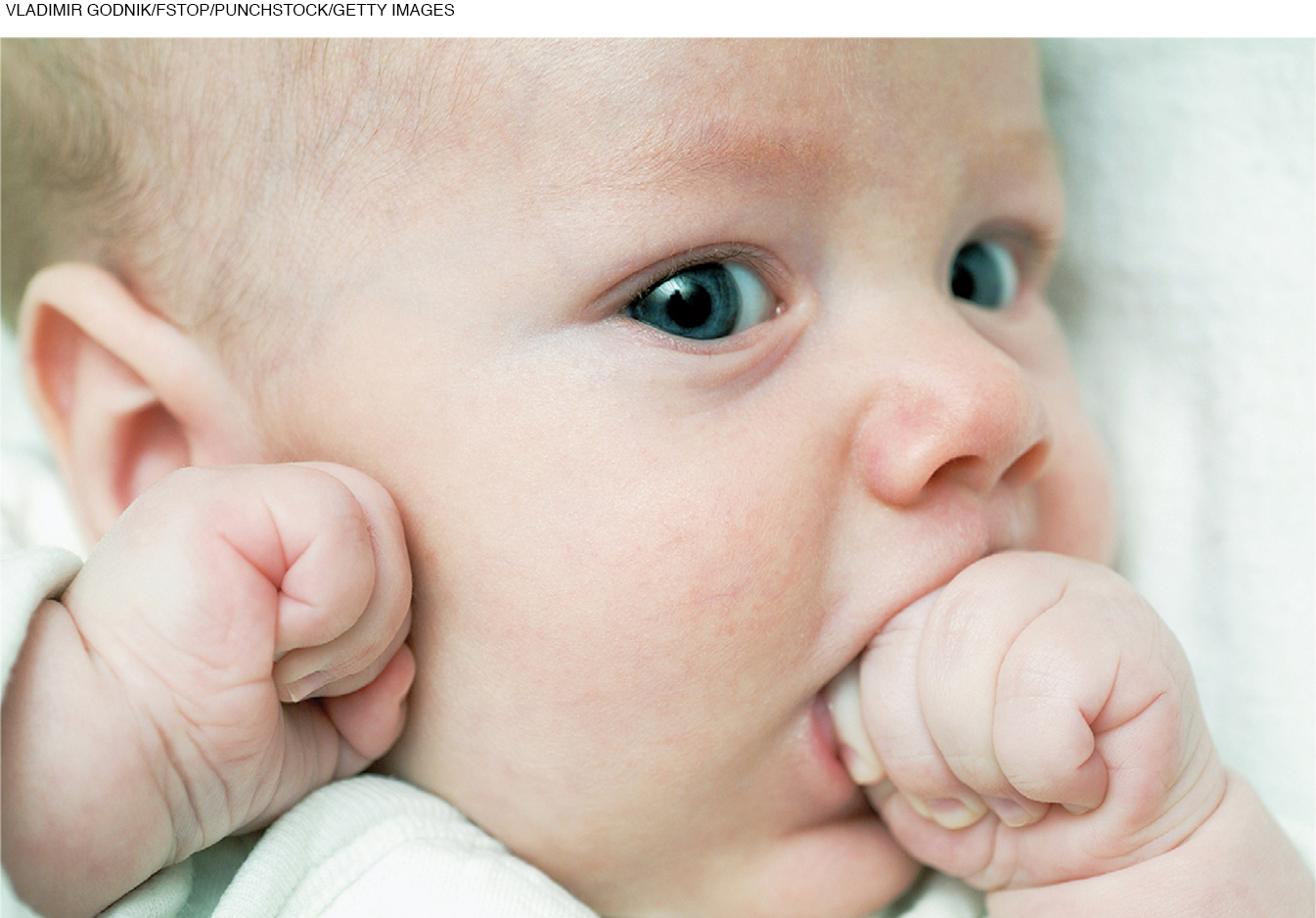
During stage two, which Piaget pegged from about 1 to 4 months of age, additional adaptation occurs. Infant cognition leads babies to suck in some ways for hunger, in other ways for comfort—
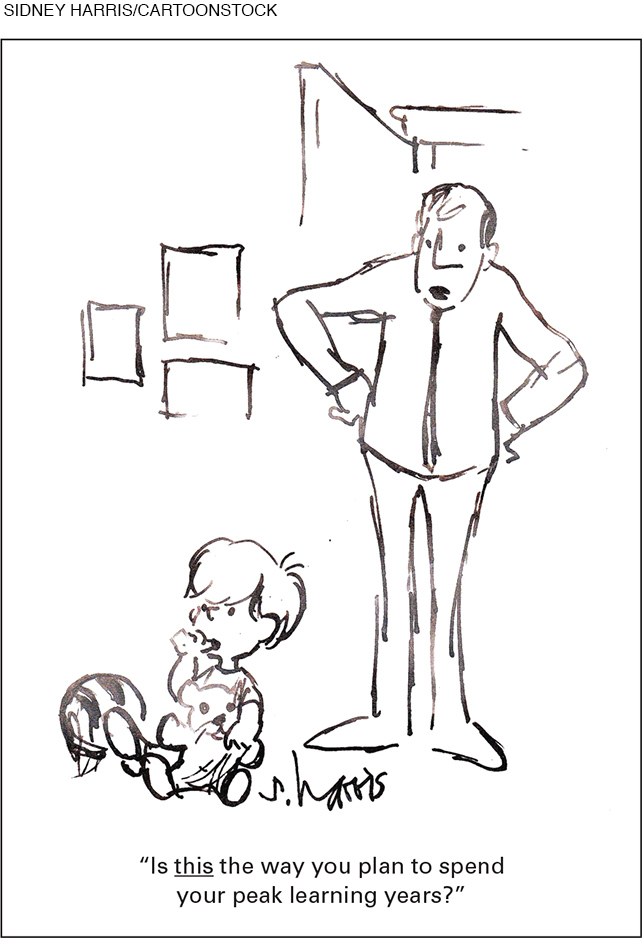
STAGES THREE AND FOUR In stages three and four, reactions are no longer confined to the infant’s body; they are an interaction between the baby and something else. During stage three (4 to 8 months), infants attempt to produce exciting experiences, making interesting sights last.
The word sights refers to more than what is seen: At this stage, babies try to continue any pleasing event. Realizing that rattles make noise, for example, they wave their arms and laugh whenever someone puts a rattle in their hand. The sight of something delightful—
Next comes stage four (8 months to 1 year), new adaptation and anticipation (also called the means to the end). Babies may ask for help (fussing, pointing, gesturing) to accomplish what they want. An impressive attribute of stage four is that babies work hard to achieve their goals. Babies who are 10 months old, seeing a parent putting on a coat, might drag over their own jackets to signal that they want to go along.
Stage-
With a combination of experience and brain maturation, babies become attuned to the goals of others, an ability much more evident at 10 months than 8 months (Brandone et al., 2014). Personal understanding begins to extend to social understanding.
object permanence
The realization that objects (including people) still exist even if they can no longer be seen, touched, or heard.
OBJECT PERMANENCE Piaget thought that, at about 8 months, babies first understand the concept of object permanence—the realization that objects or people continue to exist when they are no longer in sight. As Piaget discovered, not until about 8 months do infants search for toys that have fallen from the crib, rolled under a couch, or disappeared under a blanket. Blind babies also acquire object permanence toward the end of their first year, reaching for an object that they hear nearby (Fazzi et al., 2011).
As a recent statement of this phenomenon explains:
Many parents in our typical American middle-
[Xu, 2013, p. 167]
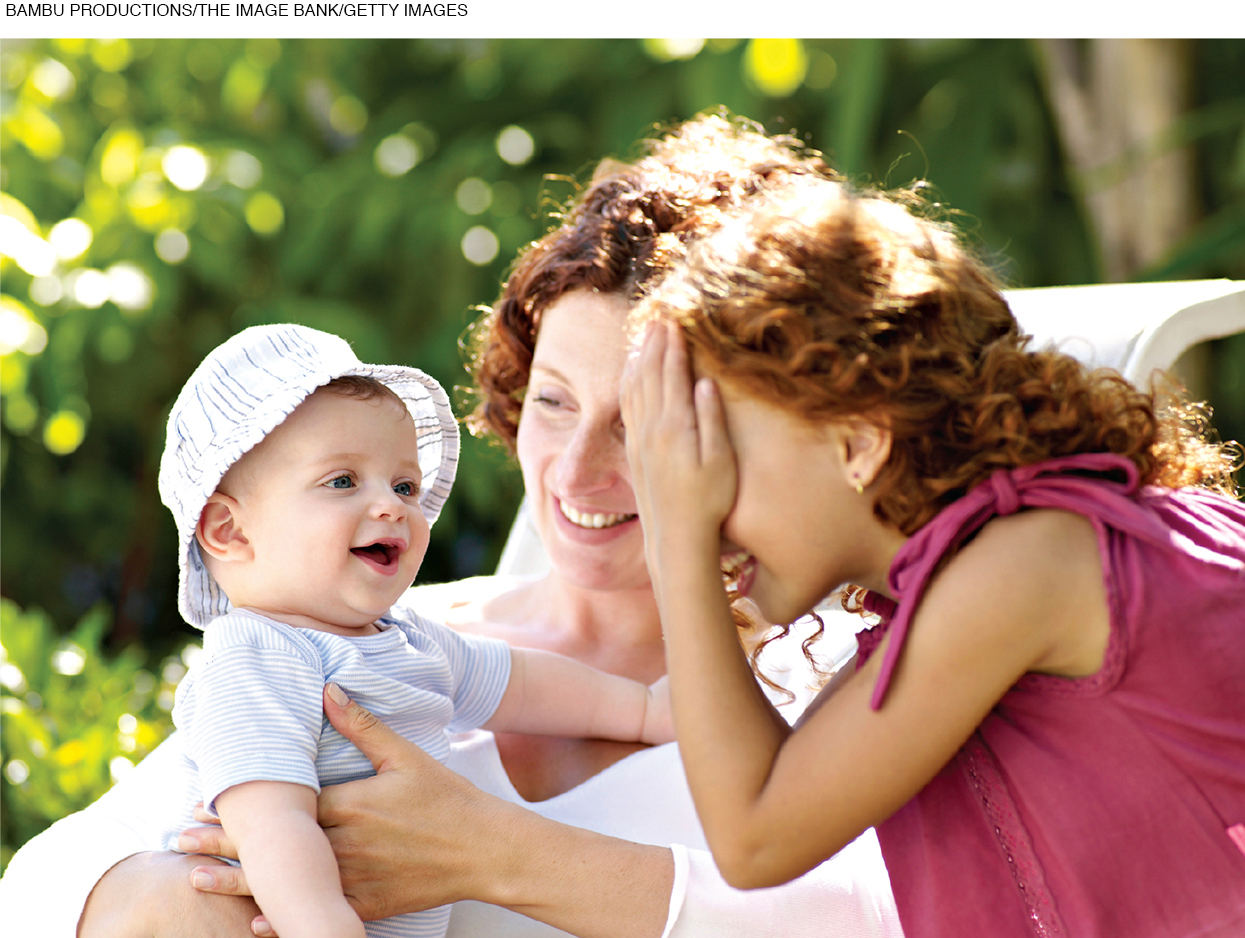
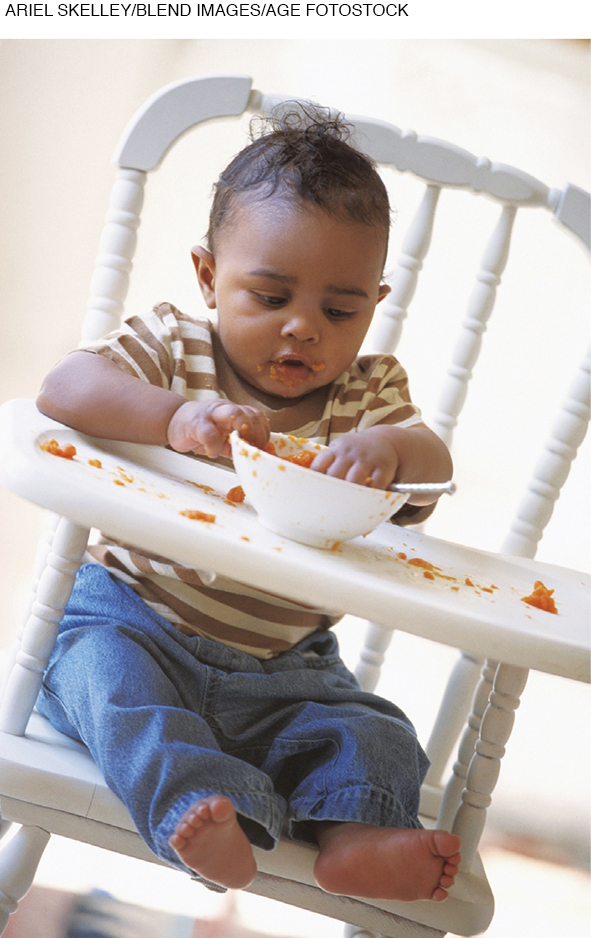
This excerpt describes Piaget’s classic experiment to measure object permanence: An adult shows an infant an interesting toy, covers it with a lightweight cloth, and observes the response. The results:
Infants younger than 8 months do not search for the object by removing the cloth.
At about 8 months infants search, removing the cloth immediately after the object is covered but not if they have to wait a few seconds.
At 18 months, they search quite well, even after a wait, but not if they have seen the object put first in one place and then moved to another. They search in the first place, not the second, a mistake called the A-
not- . Thus they search where they remember seeing it put (A), somehow not understanding that they saw it moved (to B). When a healthy, bright toddler exhibits this obvious failing, observers usually agree with Piaget: A-B error not- B is a sign of immature brain development. By 2 years, children fully understand object permanence, progressing through several stages of ever-
advanced cognition (Piaget, 1954/2013).
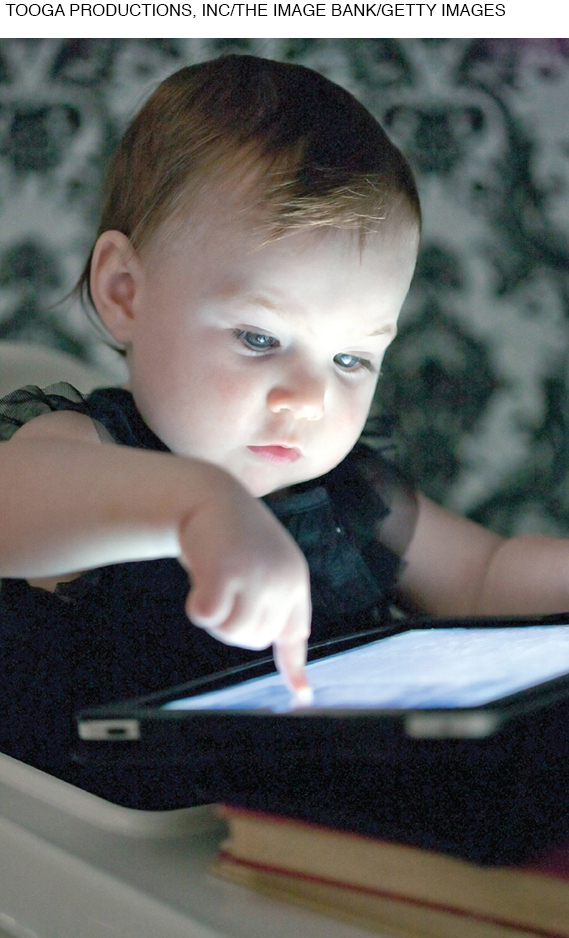
This sequence has intrigued scientists as well as parents for decades.
Renee Baillargeon devised a series of clever experiments in which objects seemed to disappear behind a screen while researchers traced babies’ eye movements and brain activity. The data reveals that long before 8 months, infants are surprised if an object vanishes (Baillargeon & DeVos, 1991; Spelke, 1993).
The conclusion that surprise (measured by infant gaze) indicates object permanence is accepted by some scientists, who believe that “infants as young as 2 and 3 months of age can represent fully hidden objects” (Cohen & Cashon, 2006, p. 224). Other scientists are not convinced (Mareschal & Kaufman, 2012).
STAGES FIVE AND SIX In their second year, infants start experimenting in thought and deed—
little scientist
The stage-
Video: Event-
Toddlers delight in squeezing all the toothpaste out of the tube, drawing on the wall, or uncovering an anthill—
Finally, in the sixth stage (ages 18 to 24 months), toddlers use mental combinations, intellectual experimentation via imagination that can supersede the active experimentation of stage five. Because they combine ideas, stage-
Thus, the stage-
The ability to combine ideas allows stage-
deferred imitation
A sequence in which an infant first perceives something done by someone else and then performs the same action hours or even days later.
Piaget describes another stage-
who got into a terrible temper. He screamed as he tried to get out of a playpen and pushed it backwards, stamping his feet. J. stood watching him in amazement, never having witnessed such a scene before. The next day, she herself screamed in her playpen and tried to move it, stamping her foot lightly several times in succession.
[Piaget, 1962/2013, p. 63]
These words from Piaget illustrate his genius: He observed children carefully, noticing how they thought at each stage. However, many researchers find that Piaget underestimated the age at which various accomplishments occurred. You already saw this with object permanence; the same is true for deferred imitation.
Scientists were awed by Piaget’s recognition that babies “learn so fast and so well” (Xu & Kushnir, 2013, p. 28). For decades researchers followed Piaget’s lead, and they demonstrated that infants master cognition in much the way Piaget described.
However, as brain scans and computerized analysis of heart rate, muscle tension, gaze, and so on made it easier to study infant cognition, Piaget’s emphasis on senses and motor abilities seems to have limited his understanding of infant cognition. Piaget missed many early cognitive accomplishments, particularly in memory (Schneider, 2015).
Information Processing
information-
A perspective that compares human thinking processes, to computer analysis of data, including sensory input, connections, stored memories, and output.
As explained in Chapter 1, Piaget’s sweeping overview of four periods of cognition contrasts with information-
The thinking of young infants is impressive. As one researcher summarizes, “Rather than bumbling babies, they are individuals who … can learn surprisingly fast about the patterns of nature” (Keil, 2011, p. 1023). Concepts and categories develop in infants’ brains by 6 months or earlier (Mandler & DeLoache, 2012).
MEMORY AT 3 MONTHS We focus now on one specific ability that Piaget underestimated, memory (Schneider, 2015). Within the first weeks after birth, infants recognize their caregivers by face, voice, and smell. Memory improves month by month. In one study, after 6-
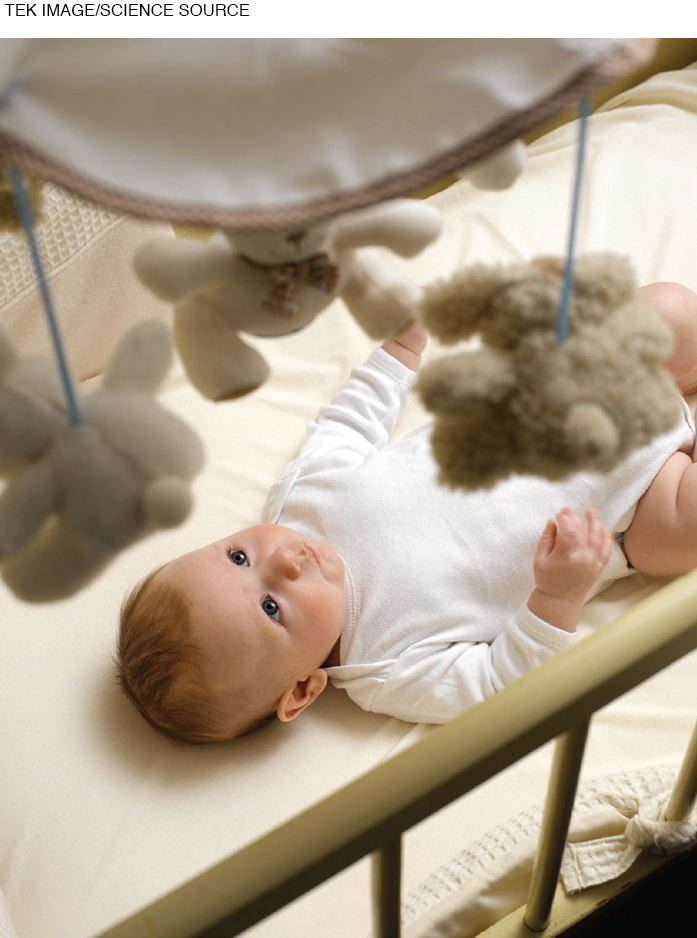
In studying memory, researchers realize that, instead of noticing children’s many “faults or shortcomings relative to an adult standard,” we need to appreciate that children remember what they need to remember (Bjorklund & Sellers, 2014, p. 142). Sensory and caregiver memories are apparent in the first month, motor memories by 3 months, and then, at about 9 months, more complex memories including for language (Mullally & Maguire, 2014).
No doubt memory is fragile in the first months of life and improves with age. Repeated sensations and brain maturation are required in order to process and recall whatever happens (Bauer et al., 2010). Everyone’s memory fades with time, especially if that memory was never encoded into language, never compared with similar events, never discussed with a friend. No wonder infants forget many things.
That forgetfulness led Piaget, Freud, and other early developmentalists to write about infant amnesia, the idea that people forget everything that happened to them before age 3. However, although adults do not remember what happened at age 1, that does not mean that infants have no memory. Infants remember things that happened weeks and even months ago (Mullally & Maguire, 2014), although they are unlikely to remember it decades later.
The most dramatic proof of very early memory comes from a series of innovative experiments in which 3-
Virtually all the babies realized that kicking made the mobile move. They then kicked more vigorously and frequently, sometimes laughing at their accomplishment. So far, this is no surprise—
When infants as young as 3 months had the mobile-
But then the lead researcher Carolyn Rovee-
Video: Contingency Learning in Young Infants shows Carolyn Rovee-
Apparently, watching the mobile the previous day revived their faded memory. Other research similarly finds that reminders are powerful. In real life, an infant who is reminded, day after day, is likely to remember several weeks later. If Daddy plays with a 3-
OLDER INFANTS At 9 months, memory markedly improves. This may partly be the result of new motor ability, since 9-
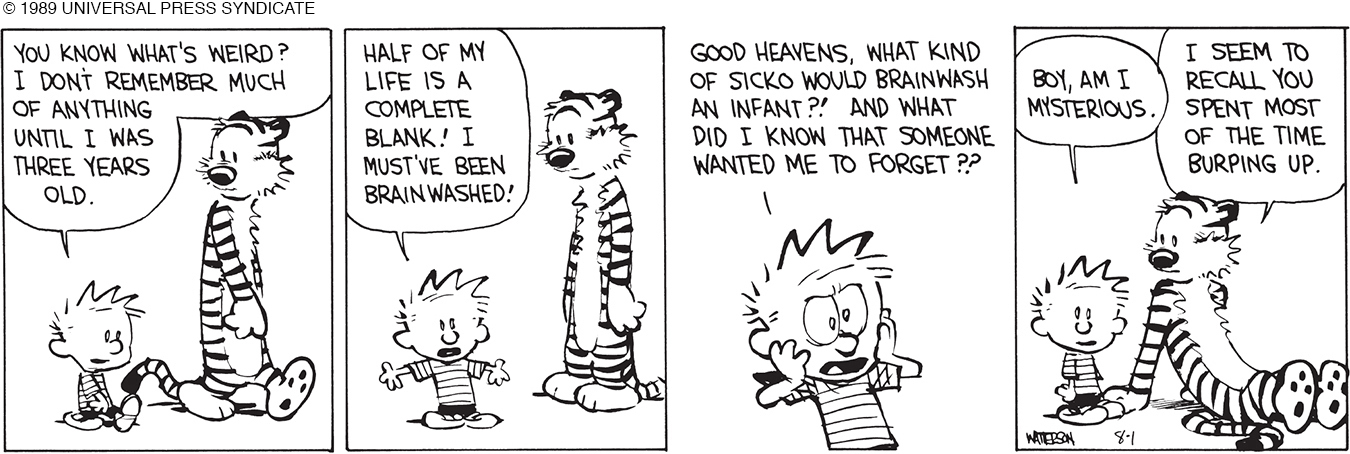
The crucial insight from information-
WHAT HAVE YOU LEARNED?
Question 3.23
1. Why did Piaget call cognition in the first two years “sensorimotor intelligence”?
Piaget labeled cognition in the first two years sensorimotor intelligence because infants learn through their senses and motor skills.
Question 3.24
2. How does stage one of sensorimotor intelligence lead to stage two?
Stage one, called the stage of reflexes, lasts only a month. It includes senses as well as motor reflexes, the foundations of infant thought. Soon sensation leads to perception, which ushers in stage two, first acquired adaptations (also called the stage of first habits).
Question 3.25
3. In sensorimotor intelligence, what is the difference between stages three and four?
Babies in stage three are between 4 and 8 months old. This stage is about making interesting sights last and responding to people and objects. Stage-
Question 3.26
4. Why is the concept of object permanence important to an infant’s development?
Once an infant grasps the concept of object permanence, he or she is able to understand that objects or people continue to exist when they are no longer in sight.
Question 3.27
5. What does the active experimentation of the stage-
Parents need to be on their toes with a stage-
Question 3.28
6. Why did Piaget underestimate infant cognition?
Piaget’s methods for determining what infants could think relied only on direct observation of behavior. Today, scientists have many ways of measuring brain activity long before any observable evidence is apparent.
Question 3.29
7. What conditions help 3-
Researchers find that reminders help infants remember. In addition, the context is crucial, especially for infants younger than 9 months old.
Question 3.30
8. How does the infant brain respond to experiences?
The dendrites of several areas of the brain grow to reflect remembered experiences.